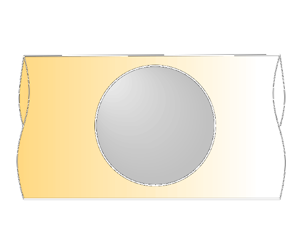Article contents
Isotropically active particle closely fitting in a cylindrical channel: spontaneous motion at small Péclet numbers
Published online by Cambridge University Press: 26 January 2024
Abstract

Spontaneous motion due to symmetry breaking has been predicted theoretically for both active droplets and isotropically active particles in an unbounded fluid domain, provided that their intrinsic Péclet number  $Pe$ exceeds a critical value. However, due to their inherently small
$Pe$ exceeds a critical value. However, due to their inherently small  $Pe$, this phenomenon has yet to be observed experimentally for active particles. In this paper, we demonstrate theoretically that spontaneous motion for an active spherical particle closely fitting in a cylindrical channel is possible at arbitrarily small
$Pe$, this phenomenon has yet to be observed experimentally for active particles. In this paper, we demonstrate theoretically that spontaneous motion for an active spherical particle closely fitting in a cylindrical channel is possible at arbitrarily small  $Pe$. Scaling arguments in the limit where the dimensionless clearance is
$Pe$. Scaling arguments in the limit where the dimensionless clearance is  $\epsilon \ll 1$ reveal that when
$\epsilon \ll 1$ reveal that when  $Pe=O(\epsilon ^{1/2})$, the confined particle reaches speeds comparable to those achieved in an unbounded fluid at moderate (supercritical)
$Pe=O(\epsilon ^{1/2})$, the confined particle reaches speeds comparable to those achieved in an unbounded fluid at moderate (supercritical)  $Pe$ values. We use matched asymptotic expansions in that distinguished limit, where the fluid domain decomposes into several asymptotic regions: a gap region, where the lubrication approximation applies; particle-scale regions, where the concentration is uniform; and far-field regions, where solute transport is one-dimensional. We derive an asymptotic formula for the particle speed, which is a monotonically decreasing function of
$Pe$ values. We use matched asymptotic expansions in that distinguished limit, where the fluid domain decomposes into several asymptotic regions: a gap region, where the lubrication approximation applies; particle-scale regions, where the concentration is uniform; and far-field regions, where solute transport is one-dimensional. We derive an asymptotic formula for the particle speed, which is a monotonically decreasing function of  $\overline {Pe}=Pe/\epsilon ^{1/2}$ and approaches a finite limit as
$\overline {Pe}=Pe/\epsilon ^{1/2}$ and approaches a finite limit as  $\overline {Pe}\searrow 0$. Our results could pave the way for experimental realisations of symmetry-breaking spontaneous motion in active particles.
$\overline {Pe}\searrow 0$. Our results could pave the way for experimental realisations of symmetry-breaking spontaneous motion in active particles.
JFM classification
- Type
- JFM Papers
- Information
- Copyright
- © The Author(s), 2024. Published by Cambridge University Press
References
- 1
- Cited by



